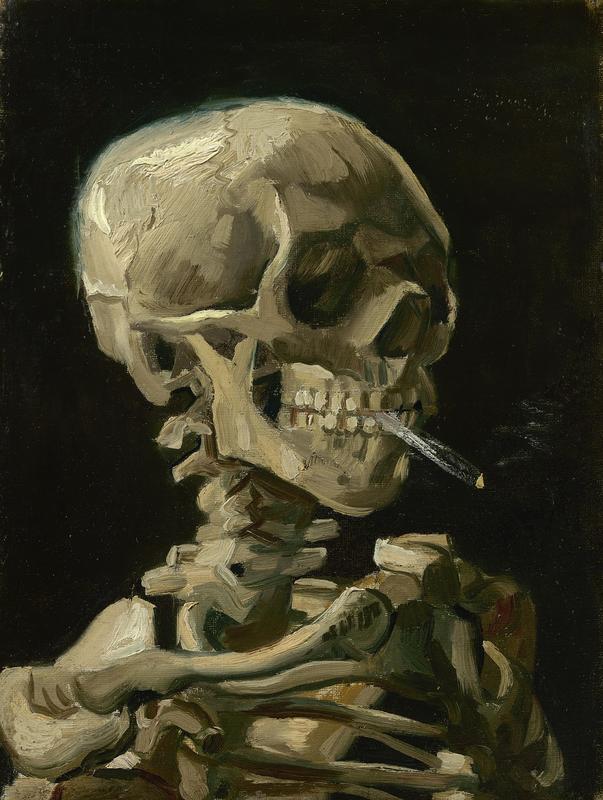More about Head of a Skeleton with a Burning Cigarette
- All
- Info
- Shop

Contributor
Vincent van Gogh's Head of a Skeleton with a Burning Cigarette was created during a period of considerable trials and tribulations.
The ideas of unrecognized genius, the artist born in the wrong time period, and the apparently Promethean economic riskiness of pursuing art as a vocation have become fundamental supports of today's critical discourse about van Gogh, but the artist felt that his incredible skill would ultimately outweigh these risks. He was willing to give the "ultimate sacrifice" for his work: the possibility that nobody would appreciate it until long after the artist was personally able to soak up the accolades.
In 1885, van Gogh was living with his parents in Nuenen, thoroughly disappointing them by throwing himself headfirst into his character studies of peasants. He became a kind of embedded journalist of art, spending days in the fields with the "people of the land," in order to approximate their way of life with his brushstrokes. However, one of his sitters, Gordina de Groot, got pregnant, and, partly because of his prior scandalous relationship with Clasina Maria "Sien" Hoornik and her family, van Gogh couldn't avoid the rumors that he was infecting the sitters with immorality. It didn't matter that Gordina, according to the artist, had shared the name of the actual father; there was no Maury Povich to give her a DNA test, and the local sexton forced van Gogh out.
Following the loss of his own father, van Gogh moved to Antwerp, where he barely managed to rent a room above a paint store, from Willem Henricus Brandel and his wife Anna Wilhelmina Huberta. He enrolled at the Academy of Fine Arts Antwerp in January 1886. During his time in art school between January and March, he composed the unusual Head of a Skeleton with a Burning Cigarette. The fact that van Gogh was suffering from the ravages of syphilis has been established by local researchers, although vehemently denied by his nephew, who owned this work before it came into the possession of the Van Gogh Museum. To make things worse, van Gogh was literally starving: the artist wrote to his brother on February 3rd that he was living "without any money for a dinner, because the work costs me too much…I have made my health worse by smoking a great deal, which I did the more because then one does not feel an empty stomach so much."
Flummoxed by the odd combination of humor and the grotesque in this work, the Dutch seem to have published almost nothing about Head of a Skeleton with a Burning Cigarette, aside from the writer Johannes Stellingwerff's 1959 joke, in his doctoral thesis, about van Gogh's possible motivation for painting this work: "Respect for the human form cannot be the reason…"
Sources
- Hayden, Deborah. Pox: Genius, Madness, And The Mysteries Of Syphilis. New York: Basic Books, 2008.
- van Heugten, Sjraar. Vincent Van Gogh: Nuenen, 1883-1885. Amsterdam: Van Gogh Museum, 1997.
- Hulsker, Jan. Vincent van Gogh: een leven in brieven 1853-1890. Amsterdam: Meulenhoff Boekerij B.V., 2012.
- de Leeuw, Ronald. Van Gogh Museum: schilderijen en pastels. Zwolle: Waanders, 1993.
- "Letter from Vincent van Gogh to Theo van Gogh." Van Gogh's Letters, http://www.webexhibits.org/vangogh/letter/16/449.htm.
- Naifeh, Steven W., and Gregory White Smith. Van Gogh: The Life. New York: Random House, 2011.
- Stellingwerff, Johannes. Werkelijkheid en grondmotief bij Vincent Willem van Gogh. Amsterdam: Swets & Zeitlinger, 1959.
Featured Content
Here is what Wikipedia says about Skull of a Skeleton with Burning Cigarette
Skull of a Skeleton with Burning Cigarette (Dutch: Kop van een skelet met brandende sigaret) is an early work by Vincent van Gogh. The small and undated oil-on-canvas painting featuring a skeleton and cigarette is part of the permanent collection of the Van Gogh Museum in Amsterdam. It was most likely painted in the winter of 1885–86 as a satirical comment on conservative academic practices. Before it was common to use live humans as models, the academic routine included the study of skeletons to develop an understanding of human anatomy. Van Gogh was in Antwerp, Belgium at that time attending classes at the Royal Academy of Fine Arts, which he later said were boring and taught him nothing.
Van Gogh included skeletons in another work from his Antwerp period, a sketch of a "Hanging skeleton and cat". In 1887–88, van Gogh painted two more paintings with skulls, the only other works of his (besides a drawing from the same period) to use skulls as a motif.
The work measures 32 by 24.5 centimetres (12.6 in × 9.6 in). It is considered a vanitas or memento mori, at a time when van Gogh himself was in poor health. It may be influenced by works of Hercules Segers, a 17th-century Dutch artist, or of Félicien Rops, a Belgian contemporary of van Gogh. Although often interpreted as a criticism of smoking, Van Gogh was a keen smoker himself, and continued to smoke until his death in 1890.
The painting was held by Van Gogh's brother Theo Van Gogh at the time of his death in 1891. It was inherited by his widow Johanna van Gogh-Bonger until her death in 1925, and then by their son Vincent Willem van Gogh until 1962, when it was acquired by the Van Gogh Foundation. It was on loan to the Stedelijk Museum from 1962 to 1973, and has been on permanent loan to the Van Gogh Museum in Amsterdam since 1973.



Check out the full Wikipedia article about Skull of a Skeleton with Burning Cigarette

















It's very interesting